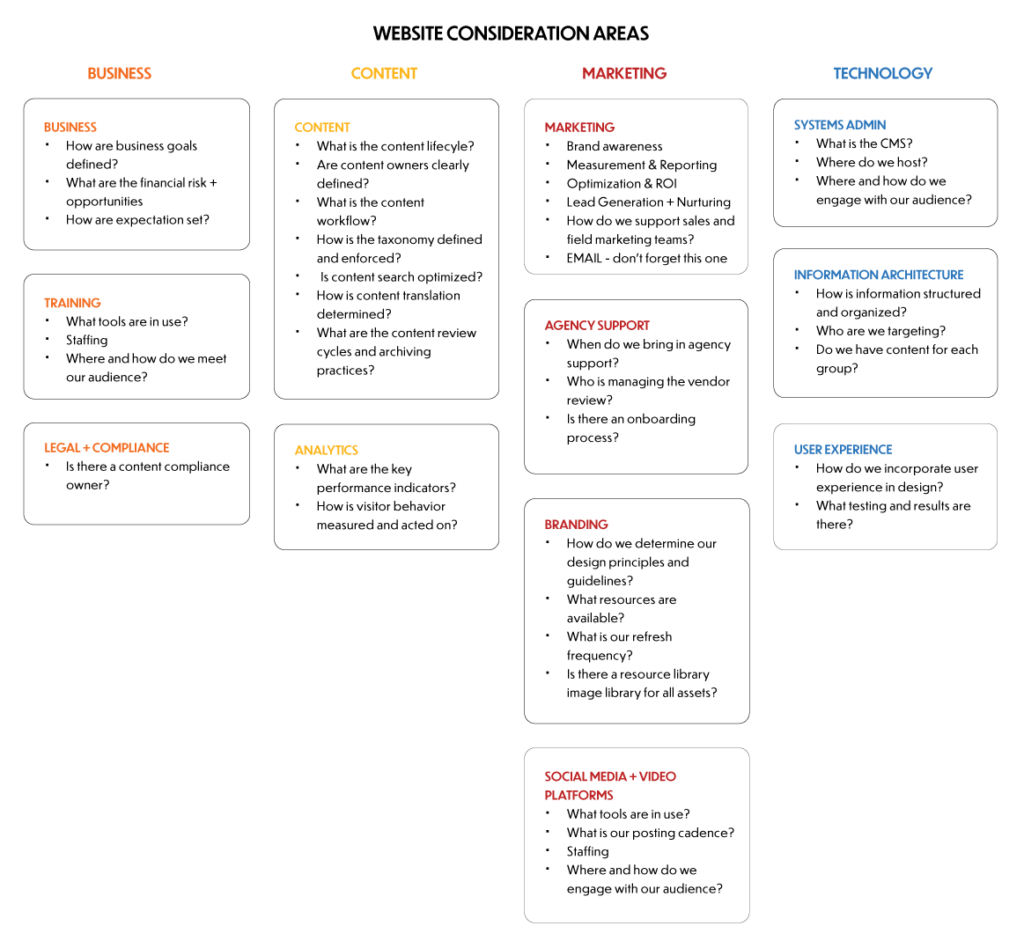What is a website governance framework and why does my company need one?

Table of Contents
- The Problems of Governing a Mid to Large-scale Website
- What is a Website Governance Framework?
- AI Changed the Rules
- The Benefits of a Governance Framework
- Getting Started
Who is doing what, and when, to my website?!#?
If your company hosts a mid to large-scale website with hundreds of thousands of pages, you likely have multiple, geographically dispersed, siloed teams and a range of content creators. The question is: who’s doing what, when, and under whose rules?
Are portions of your site inconsistent in voice, look and feel and brand messaging? Who can upload content, and what happens when content is inconsistent or out of date?
Who’s tracking the hundreds of pages that haven’t had a single Google visitor in months and are weighing the whole site down?
Who is responsible for performance? How is it measured and by whom?
It’s not just policies and procedures. It’s control. It’s clarity. It’s knowing who owns what and stopping chaos before it starts. No more marketers rewriting the homepage on a whim. No more rogue devs pushing surprise updates at 10 p.m.
Sound familiar?
We worked with a company that had about 25 people touching their website – marketing, sales, product teams, IT.
Nobody was really in charge. No process for anything. Someone would delete pages without setting up redirects.
There were tons of old PDFs just sitting there. Duplicate files everywhere.
When they decided to relaunch the site, all that mess made everything take twice as long. Everyone kept saying “I thought someone else was handling that.”
Shall I continue?
Who’s minding the content lifecycle—by section and across the entire site?
What happens to legacy pages when you rebrand or relaunch part of the site?
What about the hundreds of outdated PDFs still carrying the old logo and messaging? Who’s in charge of those?
And what happens when people leave the company; is there content continuity? Does anyone even know what content they owned??
How about compliance? Is the team fully cognitive and complaint with the relevant geographical-based website compliance requirements at location Y? Is all of your website compliant with the relevant legal requirements?
If you or your colleagues are unable to answer all these questions definitively, your company needs a website governance framework. And you’re not alone in your frustration. As websites become increasingly complex and expand in terms of the number of stakeholders and the volume of content, a governance framework is essential.
We can help!
AI Changed the Rules.
AI tools are creating content, writing metadata, even making decisions. But who’s checking their work?
If ChatGPT writes your product descriptions or translates your content, who’s making sure it’s accurate and on-brand?
The risks are real: content gets published without human review, AI generates biased or incorrect information, and when something goes wrong, there’s no audit trail.
Your governance framework needs to cover AI oversight – who approves AI content, how you track what tools were used, and when to retire AI-generated material that’s no longer accurate. Outline AI oversight: when it can be used, reviewed, or retired. Download our AI Employee Acceptable Use Policy to guide your teams.
Governance isn’t just about people anymore. It’s about people and machines—working together without blowing things up.
What your governance framework needs now:
- AI oversight – Who creates, edits, approves?
- Clear records – What AI was used? When? For what purpose?
- Audit plans – Can you trace back what AI generated?
- Bias checks – Is it accurate, brand-safe, and legal?
- Deletion rules – Do you know what AI-generated content to retire—and when?
Without governance, AI moves faster than your team can.
And that’s when mistakes turn into headlines.
What is a website governance framework?
Website governance is the framework for maintaining a corporate website.
- It provides set of policies and procedures for managing all aspects of a website.
- It provides staff with the guidance to create, manage and measure content across all digital properties. Identifies a single point of accountability including the skills required, staffing, roles & team structures.
- It guides the development and implementation of new capabilities, development pipeline, and related project work.
The benefits of a governance framework
A governance framework establishes best practices, policies and procedures related to the content, people and processes for websites (or intranets). Having a well-planned and documented governance framework helps to:
- Responsible use of AI and ChatGPT-style tools
- Avoid duplication and silos
- Speed time to completion
- Reduce costs
- Boost performance
- Maintain a consistent brand presence
- Ensure compliance
The framework should establish:
- Defined website goals and objectives
- Guidance for creating, managing and measuring content across all digital properties
- Guidance to prioritize the development and implementation of new capabilities, the development pipeline, and related project work
- A single point of accountability including the skills required, staffing, roles and team structures
- A review process to measure traffic, engagement and conversion
- Standards that can be easily replicated by all team members in any location
- A checklist to ensure a review process, documentation and budgets are in place
Getting started with your governance framework
Creating a governance framework may appear to be a daunting task. The following guide help kickstart the creation of your framework. Aim to create a strong foundation that you can continue building on over time.
Website Governance Checklist
Looking for a quick reference? Download the Website Governance Checklist as a companion guide to this framework. It summarizes the key people, process, policy, and tool responsibilities covered here.
Governance ensures AI adds value without introducing avoidable risk. Assess your organization’s AI readiness with this diagnostic tool.
Co-Author
Inbound Digital Engagement Manager at Pegasystems
We make content audits painless
Large websites tend to grow messy and inefficient over time. Outdated or low-quality quality content rarely gets any visibility and not only adds bloat to your site, but negatively affects your UX and SEO success.
So, if you haven’t done it before, it’s time to conduct a content audit to identify these ghost town pages, and then, revise or remove them.
It's content inventory time - start your own audit!
Content Inventory & Audit » Step-by-Step Guide to Running Your 1st Audit
Rosemary Brisco
AI Training Videos
AI Consulting and Training
Master today’s most effective productivity tools.
ToTheWeb ensures your route to capitalizing on the immense power of AI is fast and efficient. Our AI consulting and training programs will quickly enable your marketing team to adopt solutions to optimize operations and boost performance.
Learn about our generative AI and ChatGPT consulting and training programs




